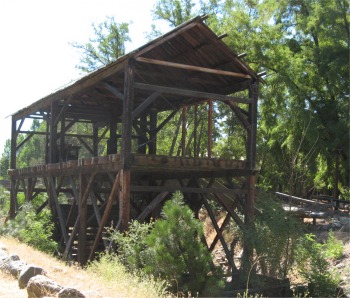 Reconstruction of Sutter's Mill at Coloma |
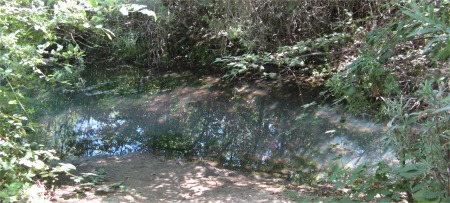 Tailrace Where Marshall Found Gold |
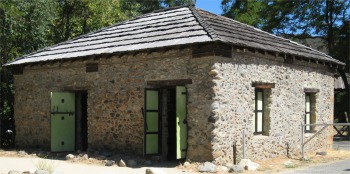 Chinese Store - The Wah Hop Building |
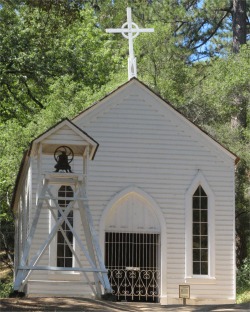 St John's Catholic Church, 1856 |
However, Sutter had bragged about the discovery, and Mormon elder Sam Brannan, who operated a general store at the fort, went to the mill to see for himself. When Brannan visited San Francisco in May, he paraded the streets waving a quinine bottle full of gold shouting, "Gold! Gold! Gold from the American River!". By the end of May, San Francisco was reported to be "half empty" as the able-bodied men departed for the mines. The excitement grew when an army officer carried a tea caddy full of gold to Washington, D.C. Shortly after President James Polk confirmed the rumours, thousands came to join the trek to the Gold Country.
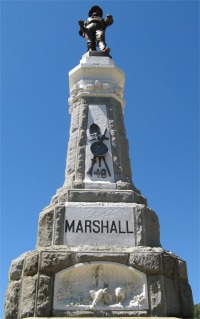 Marshall Memorial |
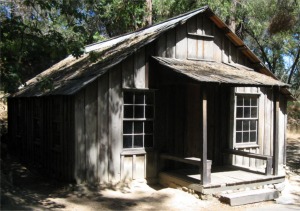 Marshall's Cabin |
From Coloma the miners moved up the canyons and into the mountains. With each new strike, and as the placer gold gave out, Coloma declined in population. By then the Chinese were almost the only workers working the gravel bars near the discovery site.
The miners had taken over Sutter's land, and both Sutter and Marshall eventually ended up penniless.
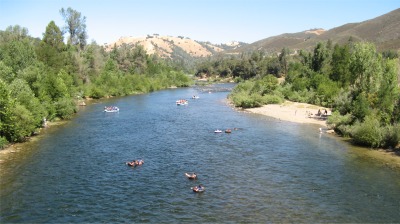 Coloma Valley |
Up on the hillside by the valley was Marshall's original cabin, and higher up the hill a monument had been placed to honour the man who had discovered gold and had been forgotten.
Looking at the peaceful valley today, it was hard to imagine this as the cradle of wealth, fortune, misery and sorrow. It had certainly turned around California's fortunes. I watched the rafters lazily floating down the gentle rapids, and wondered how many realised the significance of the river banks they were passing by.
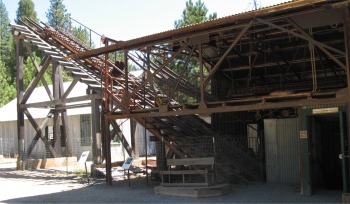 Minehead at Empire Mine |
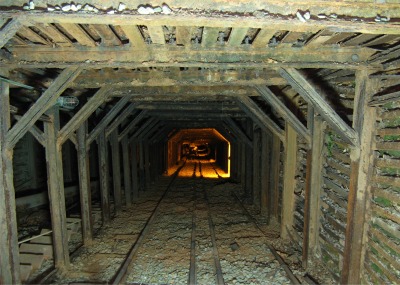 Looking Down the Inclined Shaft |
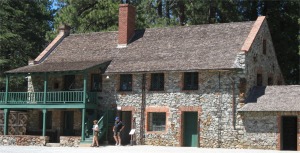 Mine Offices |
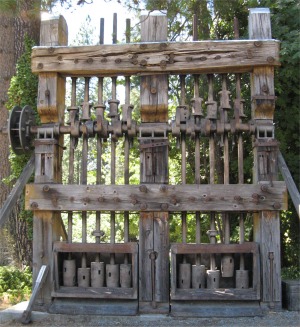 Stamp Mill for Crushing Ore |
The park had a museum which told the history of the mine, and the predominantly Cornish mineworkers. Many exhibits were outside, including an old Cornish pump. However, part of the mines success was the shift to electricity in 1890, which was more efficient for pumping. Old stamp mills were on display too. The mine offices were well preserved, as was the foundry where the gold was finally turned into bars for shipment. All the buildings were there that would be expected of a mine: machinist's workshop, blacksmiths, carpenters shop, and electrician's workshop. The minehead still existed, and it was possible to look down the inclined shaft.
The Bourne family, who ran a shipping business out east, heard about the gold rush, and thought they ought to get involved too, more specifically from the shipping of goods and materials to support the mining effort. They bought shares in the Empire Mine, and when they had a controlling interest, they took over the mine. One day each year they gave all the miners a day off for a picnic in the grounds surrounding the Bourne residence near the mine. I walked around the grounds up to the Bourne house, and took a guided tour around the house, led by role playing guides. Mr. Bourne had requested of the architect a rustic house. Inside, walls, floors and ceilings were all clad in redwood, hand planed and burnished, with no other treatment applied. The sideboard came from England, there was an elaborate wood burning cooker in the kitchen, and a huge ice box to supply smaller storage units with ice throughout the summer. They also bought their daughter a place in Ireland which was ten times larger, as a wedding present (her husband was Irish). It still stands today. Sadly, their one and only child took ill on a passage from Ireland to America, and died in New York.
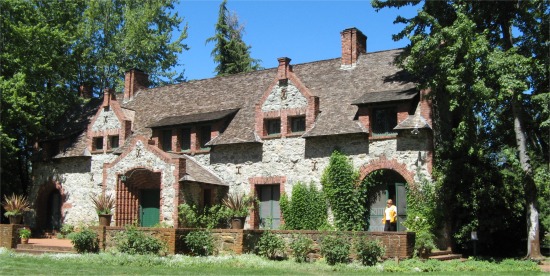 The Bourne Residence |
I departed the Gold Country and planned to head across to the coast due west. Initially I drove along I80 which would have taken me to San Francisco. The I80 bypass around Sacramento was a nightmare for about 30 miles, and made the UK M25 look positively whippet like. Once I had got around the city, I started to pick a route across country due west. There was no direct route, so I had to negotiate a string of country roads. I found myself driving through a wide plain full of sunflower fields and orchards. Then I had to cross a range of mountains which brought me down into the Napa Valley. As expected, this valley was full of vineyards.
It was now approaching dusk so I sorted out a campsite near Calistoga. Once that was done I headed into the small town for some food, and heard live jazz wafting out of the Hydro Grill, so in I went. The band was excellent, and they had a lively amount of support from the audience, with quite a few having their turn at singing and/or dancing. It was obviously a popular venue.
I left when the band finished and headed back to the campsite, arriving so whacked out that I postponed my note typing until the morning.
